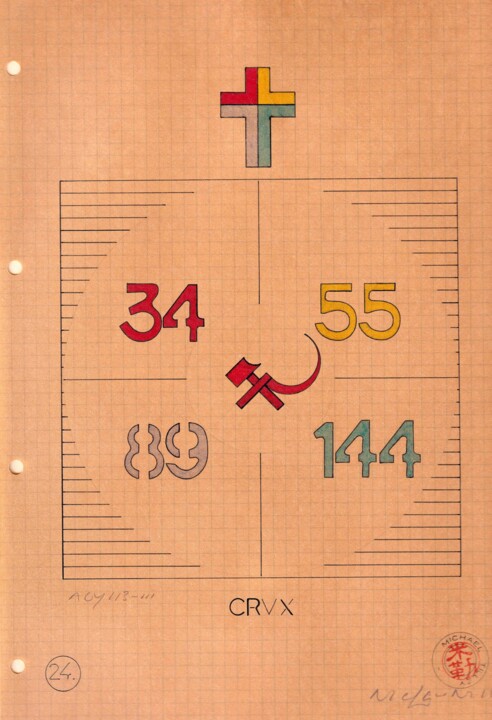


No.3: The crux dissimulata or the stupefaction of numbers (1976) Rysunek autorstwa Wilf Tilley
Sprzedawca Wilf Tilley
-
Oryginalna praca (One Of A Kind)
Rysunek,
Atrament
/
Olej
na Papier
- Wymiary Wysokość 11,8in, Szerokość 7,9in
- Stan grafiki Praca jest w bardzo dobrym stanie
- Oprawianie w ramy Ta grafika nie jest oprawiona
- Kategorie Sztuka konceptualna Religia
Powiązane tematy
Karl MarxCrux DissimulataFibonacci SequenceSymbolismSemiotics
Wilf Tilley (prof. Michael Miller) urodził się w północnej Anglii i rozpoczął karierę aktorską w wieku 16 lat w National Youth Theater w The Old Vic. w produkcji Antoniusza i Kleopatry, w której Helen Mirren grała Kleopatrę, a on niósł włócznię. „Wilf Tilley” (kombinacja imion rodziców) został częściowo adoptowany na pierwszą wystawę indywidualną w AIR Gallery w Londynie, gdy miał 27 lat. Studiował literaturę angielską i europejską z włoskim przed uzyskaniem tytułu naukowego w Royal College of Art, a także współorganizował wystawy charytatywne dla Campaign for Nuclear Disarmament i ruchu antyapartheidowego: ten ostatni w Royal Academy of Arts w Londynie. Zainteresowanie rysunkami neuroanatomicznymi Leonarda da Vinci doprowadziło, za pośrednictwem Open University, do badań nad modelowaniem neuronalnym na Wydziale Fizjologii, Anatomii i Genetyki Uniwersytetu Oksfordzkiego. Był członkiem St. Catherine's College w Oksfordzie, a po dwuletnim stypendium w International Center for Medical Research w Kobe był członkiem założycielem, a następnie starszym doradcą w RIKEN Brain Science Institute. Podczas pracy w instytucie zaprojektował i nadzorował instalację eksploratora nauk o mózgu: „BrainBox”. Wilf zorganizował osiem wystaw indywidualnych, brał udział w wystawach grupowych na całym świecie i zorganizował pierwszą retrospektywę w Japonii, „The Neuro-mytheologian And Other Works”, w 2003 roku. Druga retrospektywa odbyła się w Frederick Harris Gallery w Tokio w 2017 roku. A ostatni portret, „Manami-san (2023)”, został wybrany na wystawę New Light Art Prize w Wielkiej Brytanii i odbył tournée po pięciu galeriach w kraju (2023-2024). Jako współautor kilku neurologicznych studiów przypadku, Wilf przemawiał na konferencji w Japonii w 2017 r. na temat czasu mentalnego jako zjawiska neuronaukowego, wykorzystując techniki klasycznej retoryki – opisane w Ad Herrenium – w celu wyjaśnienia pamięci epizodycznej. Obecnie pracuje nad serią paneli, A story in silico, connected with personal memory, nostalgia and fabulation, a ostatnio opublikował dwa opowiadania o świecie sztuki w Ekphrastic Review (2022 i 2023).
-
Obywatelstwo:
JAPONIA

- Data urodzenia : nieznana data
- Domeny artystyczne:
- Grupy: Współcześni Artyści Japońscy







